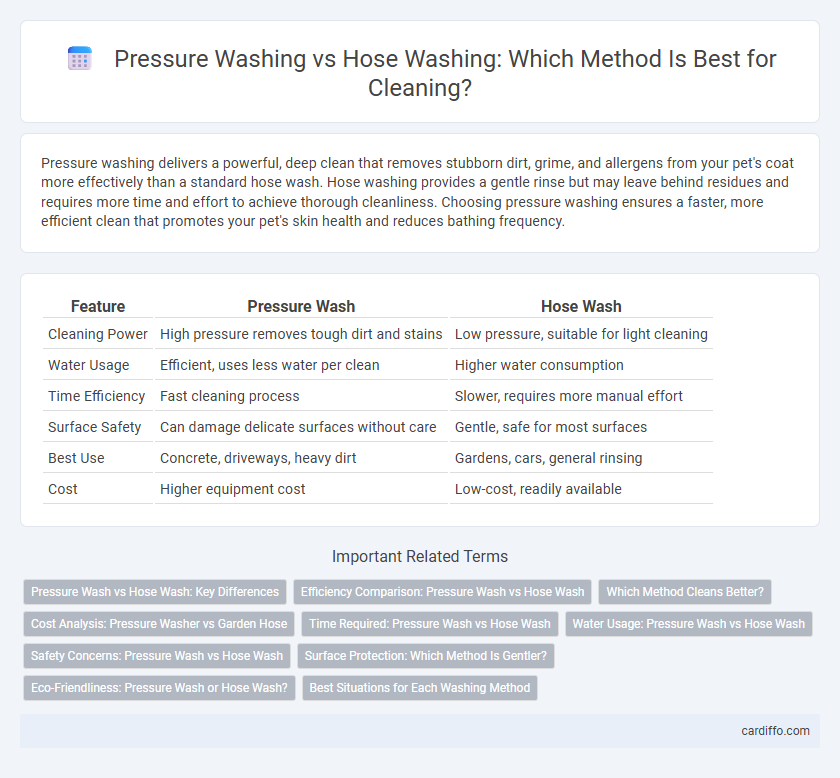Pressure washing delivers a powerful, deep clean that removes stubborn dirt, grime, and allergens from your pet's coat more effectively than a standard hose wash. Hose washing provides a gentle rinse but may leave behind residues and requires more time and effort to achieve thorough cleanliness. Choosing pressure washing ensures a faster, more efficient clean that promotes your pet's skin health and reduces bathing frequency.
Table of Comparison
| Feature | Pressure Wash | Hose Wash |
|---|---|---|
| Cleaning Power | High pressure removes tough dirt and stains | Low pressure, suitable for light cleaning |
| Water Usage | Efficient, uses less water per clean | Higher water consumption |
| Time Efficiency | Fast cleaning process | Slower, requires more manual effort |
| Surface Safety | Can damage delicate surfaces without care | Gentle, safe for most surfaces |
| Best Use | Concrete, driveways, heavy dirt | Gardens, cars, general rinsing |
| Cost | Higher equipment cost | Low-cost, readily available |
Pressure Wash vs Hose Wash: Key Differences
Pressure washing uses high-pressure water spray typically between 1,300 and 3,000 PSI to effectively remove dirt, grime, and mildew from surfaces, while hose washing relies on standard water pressure averaging around 40-60 PSI, suitable for light cleaning tasks. Pressure wash systems often incorporate detergents and specialized nozzles to tackle tough stains and large areas quickly, whereas hose washing is less efficient for deep cleaning and better suited for delicate surfaces or gardening needs. Choosing pressure washing over hose washing depends on the intensity of cleaning required, surface type, and time constraints.
Efficiency Comparison: Pressure Wash vs Hose Wash
Pressure washing uses high-pressure water jets, delivering up to 3,000 PSI or more, effectively removing tough dirt, grime, and mold in significantly less time than traditional hose washing, which operates at approximately 40-60 PSI. This higher pressure not only enhances cleaning efficiency but also reduces water consumption by targeting stubborn debris more precisely. Hose washing often requires longer durations and stronger scrubbing, leading to increased water use and labor costs compared to the rapid, deep-clean effectiveness of pressure washing systems.
Which Method Cleans Better?
Pressure washing removes dirt, grime, and mold more effectively than hose washing due to its high-powered water jets reaching up to 3,000 PSI. Hose washing relies on low water pressure, which often fails to eliminate stubborn stains and deeply embedded debris. For optimal cleanliness on surfaces like driveways, decks, and siding, pressure washing delivers superior results.
Cost Analysis: Pressure Washer vs Garden Hose
Pressure washers typically cost between $100 and $500, offering higher water pressure for efficient cleaning, while garden hoses range from $20 to $100 but deliver lower pressure and slower results. Pressure washers consume less water per minute, making them more cost-effective for large-scale or tough cleaning tasks despite the initial investment. Maintenance and operational costs are generally lower for hoses, but the increased labor time can offset those savings in extensive washing projects.
Time Required: Pressure Wash vs Hose Wash
Pressure washing significantly reduces cleaning time by using high-pressure water jets to remove dirt and grime quickly, often completing tasks in a fraction of the time required for hose washing. Hose washing relies on lower water pressure and manual scrubbing, which generally takes longer, especially for large or heavily soiled surfaces. For efficient and time-saving cleaning of driveways, decks, or siding, pressure washing is the preferred method.
Water Usage: Pressure Wash vs Hose Wash
Pressure washing uses significantly less water compared to traditional hose washing, with pressure washers consuming approximately 2 to 5 gallons per minute versus hoses using up to 10 gallons per minute. The high-pressure spray allows for efficient cleaning by removing dirt and grime quickly, reducing overall water consumption. Studies indicate pressure washing can save up to 75% more water while delivering superior results for exterior cleaning tasks.
Safety Concerns: Pressure Wash vs Hose Wash
Pressure washing exerts high water pressure that can cause injuries such as lacerations or eye damage if not handled properly, requiring protective gear and caution during use. Hose washing uses significantly lower pressure, posing fewer safety risks but may be less effective at removing tough grime and contaminants. Understanding the safety implications helps users select the appropriate method for cleaning tasks while minimizing potential harm.
Surface Protection: Which Method Is Gentler?
Pressure wash uses high-pressure water jets that can effectively remove dirt and grime but may risk damaging delicate surfaces like wood or painted finishes if not carefully controlled. Hose wash offers a gentler cleaning approach with lower water pressure, minimizing the potential for surface erosion and protecting sensitive materials. Surface protection is maximized by selecting hose wash for fragile or aged surfaces, while pressure wash suits durable, hardier exteriors where thorough cleaning is essential.
Eco-Friendliness: Pressure Wash or Hose Wash?
Pressure washing uses significantly less water, averaging 2-5 gallons per minute, compared to a garden hose that can consume up to 10 gallons per minute, making pressure washing more eco-friendly. The high efficiency and targeted cleaning action reduce runoff and minimize environmental impact by limiting detergent use and water waste. Choosing pressure washing contributes to sustainable water conservation and lowers pollution in outdoor cleaning tasks.
Best Situations for Each Washing Method
Pressure washing excels at removing stubborn dirt, mold, and grime from hard surfaces like driveways, decks, and exterior walls, providing a powerful, deep clean. Hose washing is ideal for gentle cleaning tasks such as rinsing plants, washing cars, or light dirt removal on delicate surfaces that require less force. Choosing between pressure wash and hose wash depends on surface type and dirt severity, with pressure washing suited for tough grime and hose washing preferred for everyday maintenance.
Pressure Wash vs Hose Wash Infographic

 cardiffo.com
cardiffo.com